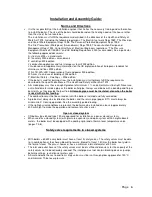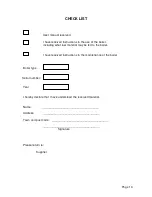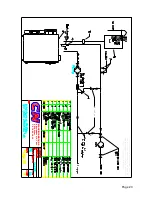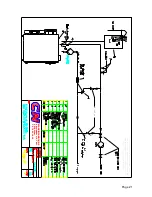
Page 10
•
When installing Water shortage protection Type RT 200 Pressostat, the installation engineer must
adjust the pressostat so that it stops the system, when the operational pressure is below 0.5 bar over
pressure. Furthermore, the installation engineer must test that the pressostat physically stops the
system when the operational pressure < 0.5. This is done by filling the system to more than 0.5 bar
over pressure, starting the system and shut off the water supply until the system stops; this should
happen at 0.5 bar over pressure.
Maintenance and cleaning:
•
The closing mechanisms of the door and cleaning hatch are adjusted from the factory but must be
inspected for correct sealing after a month of use, when the gasket has ”settled”.
•
If any irregularities are found in the safety valve(s), expansion vessel or automatics of the unit, the
owner/user must immediately have the equipment in question inspected and repaired by an
authorised engineer. The owner/user must ensure that any installed safety valves are not blocked by
scale etc. It is the responsibility of the owner/user that the boiler and any equipment is cleaned and
maintained according to:
•
Normal practice,
•
The boiler flue system is cleaned by opening the top hatch of the boiler. The many flue pipes placed
at the top of the boiler should be cleaned every 3 days with the round cleaning brush/cleaning tool
supplied with the boiler. Push the brush all the way through; take care not to damage the bottom tile
in the smoke box. Pull the brush / cleaning tool back out; repeat several times for each pipe. After
cleaning, empty the smoke box at the back of the boiler. The boiler must always be switched off
during cleaning. Clean smoke pipes and smoke box result in more economical operation.
•
The boiler combustion chamber should be cleaned every 24 hours (of use).
•
If the boiler is switched off for a long period (approximately 1 week), the boiler and flue pipes should
be cleaned thoroughly, as the residue combined with damp results in corrosion
.
•
The pump(s) must be switched off whilst the system is filled up with water
•
NOTE: Do not fill up an overheated boiler with water.
•
Installation with pressure expansion: water filling until 1.5-2.0 bar.
•
Installation with open expansion: water filling until the water runs out of the expansion vessel
overflow.
•
Testing the safety valves
: It is the responsibility of the user that the installed safety valves are
tested twice annually. This is done by pressing or turning the valve test device. By doing this you are
able to see and hear a bit of water being released and thereby confirm that the valve is operational.
Damages caused by a blocked safety valve are not covered by the warranty issued by CN
MASKINFABRIK A/S.
•
Safety valves are installed in connection with the central heating unit (2.5 bar) and possibly in
connection with the hot water circuit (6 bar or 10 bar). Please ask your installation engineer if in doubt
about the location of the valves.
•
After 300 hours’ operation, nuts and bolts must be tightened and doors adjusted!
Replacing the glass string in doors
•
Open the door. Remove the old gasket, if necessary with a chisel or a screw driver. Clean the gasket
groove. Push the new gasket into the groove. Put the last end in place when this is about half done,
and then the rest. Bang the string lightly with a hammer if necessary.
Frost protection:
•
During normal operation above freezing point there is no need for frost protection.
•
The central heating unit can be protected with anti-freeze solution. Remember, however, that the hot
water container, if relevant, is not protected against frost.
•
When stopping the unit at an ambient temperature below zero, the boiler must be emptied of water.
This is done by running a hose from the bottom tap of the boiler to a drain in the floor and opening
the tap.
Summary of Contents for 120
Page 17: ...Page 17 ...







































